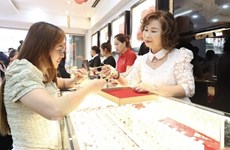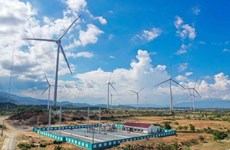New opportunities for leather and footwear exports
The Vietnamese leather, footwear and handbag industry has more room for
export development due to increased market demand and shifted production
orders to Vietnam , the Vietnam Economic News reported on August
15.
The Vietnamese leather, footwear and handbag industry has more room for
export development due to increased market demand and shifted production
orders to Vietnam , the Vietnam Economic News reported on August
15.
According to the Vietnam Leather and Footwear Association (LEFASO), the leather, footwear and handbag industry has enjoyed many development opportunities as import demand from foreign markets especially the US market is recovering and Vietnam ’s competitiveness in the EU market has improved.
Starting in January 2014, Vietnamese footwear exports to the EU benefit from a Generalized System of Preferences (GSP) tax rate of 3.5-5 percent. Many investors are looking for investment opportunities in Vietnam and increasing the number of their orders to Vietnamese businesses. Foreign partners have tended to move their orders from China and Bangladesh to Vietnam .
The leather, footwear and handbag exports earned more than 5.7 billion USD in the first seven months of 2014, up more than 19.2 percent from the same period last year.
There were many domestic and foreign projects investing in the leather and footwear industry, including supporting industry projects. The Zhu Rui Vietnam Co., Ltd from Hong Kong , China , has recently invested 10 million USD to produce molds and soles in Binh Duong province. A 16.6-billion VND project is expected to begin operation this year to produce packaging for garment, textile, leather and footwear products.
Negotiations of many free trade agreements, including a Trans-Pacific Partnership (TPP) agreement, an EU-Vietnam Free Trade Agreement, and a free trade agreement with the Customs Union of Belarus, Kazakhstan , and Russia , and are expected to be completed later this year or in 2015. Free trade agreements with ASEAN (Association of Southeast Asian Nations) countries and China , which already took effect, have provided big opportunities for the leather, footwear and handbag industry.
Director of Lien Phat Shoes Company Tran Ngoc Lien said that trade agreements will create both opportunities and challenges. Both domestic and foreign businesses are subject to the agreements, while domestic companies remain inferior to their foreign counterparts in terms of finance and business administration.
LEFASO Deputy President Diep Thanh Kiet said that the leather, footwear and handbag industry considerably depends on exports as 90 percent of its products are exported, while the domestic market is overwhelmed with imported goods. The product’s localisation rate of strategic investment products remains low. Specifically, the local input of tanned leather is only 30 percent, that of synthetic leather is 40 percent and that of decorative materials is 45 percent.
LEFASO suggested that businesses in the sector improve business administration and apply advanced management technology such as the Enterprise Resource Planning (ERP) and streamlined production to increase profits and labour productivity and reduce production costs. Each business should build its own research and development team to better satisfy customer’s requirements and improve competitiveness.-VNA
According to the Vietnam Leather and Footwear Association (LEFASO), the leather, footwear and handbag industry has enjoyed many development opportunities as import demand from foreign markets especially the US market is recovering and Vietnam ’s competitiveness in the EU market has improved.
Starting in January 2014, Vietnamese footwear exports to the EU benefit from a Generalized System of Preferences (GSP) tax rate of 3.5-5 percent. Many investors are looking for investment opportunities in Vietnam and increasing the number of their orders to Vietnamese businesses. Foreign partners have tended to move their orders from China and Bangladesh to Vietnam .
The leather, footwear and handbag exports earned more than 5.7 billion USD in the first seven months of 2014, up more than 19.2 percent from the same period last year.
There were many domestic and foreign projects investing in the leather and footwear industry, including supporting industry projects. The Zhu Rui Vietnam Co., Ltd from Hong Kong , China , has recently invested 10 million USD to produce molds and soles in Binh Duong province. A 16.6-billion VND project is expected to begin operation this year to produce packaging for garment, textile, leather and footwear products.
Negotiations of many free trade agreements, including a Trans-Pacific Partnership (TPP) agreement, an EU-Vietnam Free Trade Agreement, and a free trade agreement with the Customs Union of Belarus, Kazakhstan , and Russia , and are expected to be completed later this year or in 2015. Free trade agreements with ASEAN (Association of Southeast Asian Nations) countries and China , which already took effect, have provided big opportunities for the leather, footwear and handbag industry.
Director of Lien Phat Shoes Company Tran Ngoc Lien said that trade agreements will create both opportunities and challenges. Both domestic and foreign businesses are subject to the agreements, while domestic companies remain inferior to their foreign counterparts in terms of finance and business administration.
LEFASO Deputy President Diep Thanh Kiet said that the leather, footwear and handbag industry considerably depends on exports as 90 percent of its products are exported, while the domestic market is overwhelmed with imported goods. The product’s localisation rate of strategic investment products remains low. Specifically, the local input of tanned leather is only 30 percent, that of synthetic leather is 40 percent and that of decorative materials is 45 percent.
LEFASO suggested that businesses in the sector improve business administration and apply advanced management technology such as the Enterprise Resource Planning (ERP) and streamlined production to increase profits and labour productivity and reduce production costs. Each business should build its own research and development team to better satisfy customer’s requirements and improve competitiveness.-VNA












